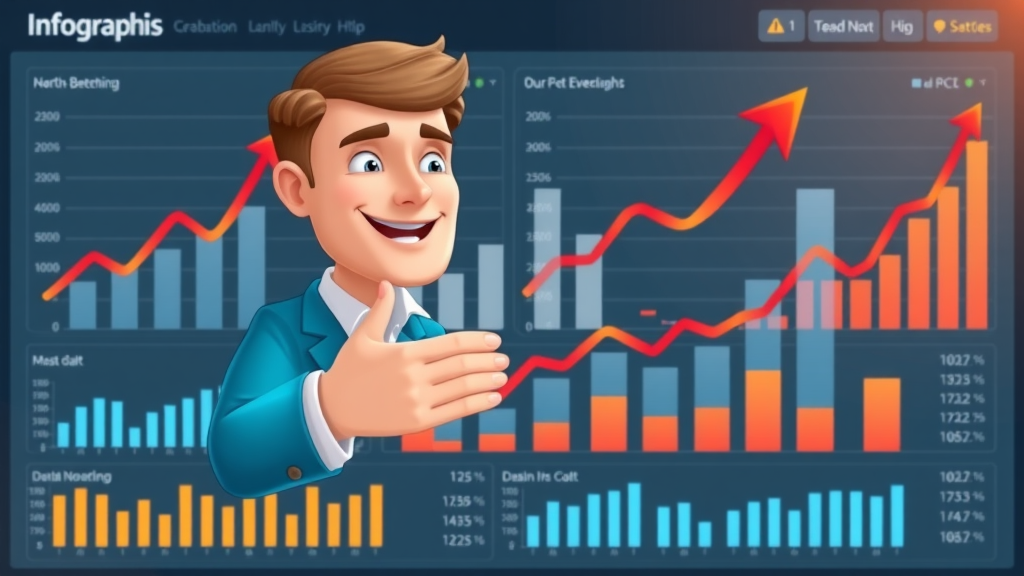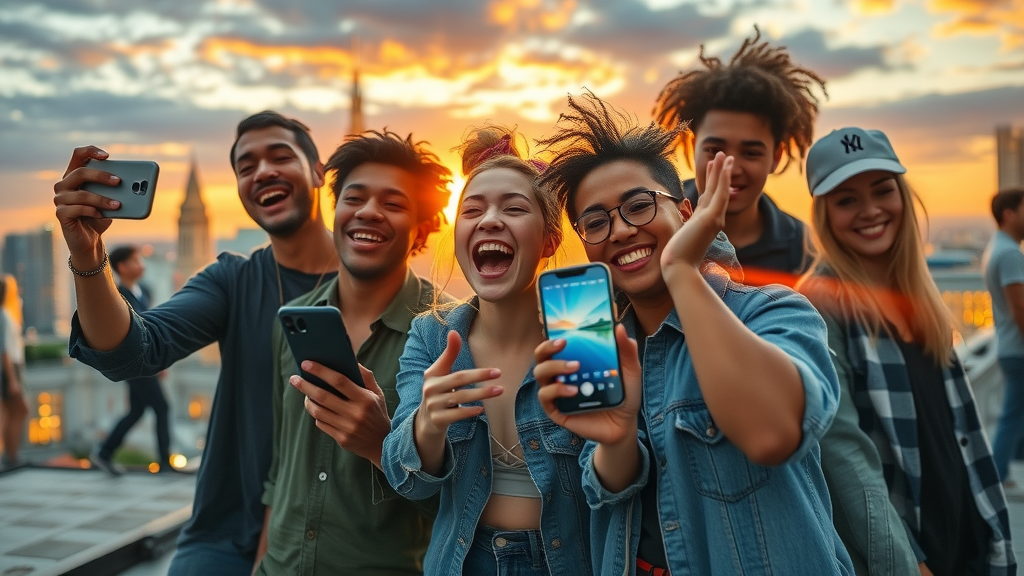Here’s a stat that should make you pause: In 2024, over 85% of global media consumption was digital. Now, as we look to 2025, all projections suggest new records will be set. Digital media, social platforms, and innovative video technologies are disrupting everything we thought we knew about the media landscape. If you want to stay relevant, knowing the media channel trends 2025 is not optional—it’s essential. Read on to discover what industry leaders are watching and what you must do to keep up!
Media Channel Trends 2025: A Data-Driven Shift in the Media Landscape
Shocking Fact: In 2024, over 85% of global media consumption was digital, and projections for 2025 point to new records. Explore why understanding media channel trends 2025 is essential for staying ahead in a rapidly evolving media landscape.

“In 2025, adaptability to dynamic media channel trends will separate the industry leaders from the rest.” – Renowned Digital Media Analyst
The media channel trends 2025 are built on a foundation of explosive growth across digital platforms, connected TV, and personalized content—pushing brands and marketers to rapidly adapt or risk falling behind. With algorithms constantly evolving and viewers’ habits shifting, digital media companies need a strategy that’s both data-driven and highly flexible. Industry experts believe that only companies prepared for ongoing disruption will rise to the top of the media landscape. This transformation isn’t about survival; it’s about seizing new opportunities in real-time and creating engaging, platform-first experiences that resonate with today’s—and tomorrow’s—audiences.
Media companies, advertisers, and content creators will need to deeply understand the proliferation of streaming platforms, AI tool integrations, and the unique power of social platforms leading the charge. As digital ad spending climbs and traditional media channels experience declines, strategic adaptation becomes the key to capturing audience attention and growing revenue streams in this high-stakes new reality.
Unveiling the Big Picture: What the Media Channel Trends in 2025 Reveal
How changing algorithms and consumption habits are shaping social media, digital media, and traditional media trends.
The 2025 media landscape is marked by a radical embrace of emerging technologies— generative AI and dynamic content delivery leading the pack. Algorithms continue to dictate not just what content is seen, but how and where it is consumed. This means platform-specific strategies—especially for digital media and social platforms—are more critical than ever. It’s not just about distributing content; it’s about creating and curating media experiences tuned to each audience and optimized for algorithmic discovery.
Platforms like Instagram, TikTok, and X are evolving to maintain engagement in the face of shrinking attention spans. Meanwhile, linear TV is quickly losing ground to connected TV and streaming services that offer greater interactivity and hyper-targeted advertising. With AI tools streamlining content curation and audience personalization, the 2025 media trends speak to a future where the line between creator and consumer blurs—and where understanding these shifts is the difference between leading and lagging behind.
As these trends accelerate, marketers and content creators must learn to recalibrate their approach, placing agility and innovation at the core of their media strategy. The brands willing to experiment with generative AI, invest in connected TV advertising, and foster authentic interaction across diverse digital platforms are the ones best positioned to capture both market share and audience loyalty.
Why You Should Care About Media Channel Trends 2025

Industry thought-leaders weigh in on how media channel trends 2025 directly affect businesses, brands, marketers, and content creators.
Whether you are a business leader, marketer, or entrepreneur, ignoring media channel trends 2025 is a recipe for missed opportunities—and lost revenue. These trends redefine how customers interact with brands, how ads are placed, and even how stories are told on digital platforms. By tracking these shifts now, you can build campaigns that outperform competitors using insights grounded in data, not guesswork. With the rapid emergence of generative AI, evolution of social platforms, and rising digital ad spend, the opportunities for growth are huge—if you’re prepared to act.
For content creators and digital media specialists, the shift opens doors to new genres, formats, and monetization models. Whether you’re leveraging AI-driven tools to streamline workflows or experimenting with innovative video content, success in 2025 will come from understanding, then anticipating, where audiences are headed next. That’s the power of staying ahead of the curve in the dynamic media landscape.
Media Channel Trends 2025: What Readers Will Gain
Actionable insights for leveraging digital media, social platforms, and innovative technologies.
Expert predictions on the trajectory of media channel trends 2025.
Practical strategies for integrating top social media and video platforms.
Expect to leave this guide with more than just knowledge—you’ll gain clear, actionable steps for putting these media trends into practice. From leveraging short-form video platforms and advanced AI tool integrations to pivoting ad spend toward connected TV and embracing niche social platforms, every recommendation is grounded in the latest data and expert insights. Discover what works, ditch what doesn’t, and test strategies designed with 2025’s media landscape in mind.
Ready to adapt? Let’s break down the specifics and see how you can achieve measurable results using the dominant media channel trends shaping digital media and social platforms right now—and in the year ahead.
Table: Media Channel Trends 2025 vs. 2024
Media Channel |
2024 Usage/Growth |
2025 (Projected) |
Key Trend |
|---|---|---|---|
Digital Media |
85% of total media consumption |
88%+ |
Dominance of AI curation & interactive content |
Social Media Platforms |
78% daily usage (adult audiences) |
80%+; micro-communities surge |
Rise of niche platforms & user-driven trends |
Connected TV |
55% of TV ad spend |
65%+; overtakes linear TV |
Interactive ads & personalized viewing |
Generative AI |
Emerging integration |
Standardized in content creation |
Personalization, scalable video, new genres |
Video Platforms |
Short-form video up 41% |
Short/interactive up 50%+ |
Dominance of TikTok, Reels, & YouTube Shorts |

Media Channel Trends 2025 Defining the Media Landscape
Social Media Platforms: Reinventing Audience Engagement
Examining how major social platforms like Instagram, TikTok, and X are introducing new features to adapt to 2025's audience behaviors.
In 2025, social media platforms are expected to double down on immersive, interactive features. Platforms like TikTok, Instagram, and X are now integrating AI-powered content personalization, real-time engagement metrics, and improved privacy controls. TikTok’s algorithm, already renowned for its stickiness, is pivoting further toward fostering micro-communities, drawing users into highly-engaged, niche content ecosystems that drive meaningful interaction—not just fleeting engagement.
Instagram and X are experimenting with shoppable live streams, video-first storytelling, and multi-platform integration that allow users to toggle between private conversations, group events, and public broadcasts. For brands, these innovations mean unleashing a new wave of creative content formats and deploying hyper-targeted ad strategies. The upshot for marketers? A need to revisit digital ad spend, favoring authentic brand storytelling and tapping micro-influencers who can connect with communities on a deeper, more personal level.
With algorithmic discovery becoming ever more precise, companies must deepen their understanding of how their audiences move across platforms, what motivates engagement, and how to leverage emerging tools for maximum resonance. The era of spray-and-pray is over—winning in 2025 means investing in connection, not just reach.
Digital Media’s Evolution in the Media Landscape

How digital media outlets are shifting to innovative formats, AI-driven content delivery, and interactive experiences.
The transformation of digital media is accelerating as outlets embrace innovative formats and advanced AI tools to drive growth. Newsrooms and creative teams now rely on sophisticated AI algorithms to not only curate but also generate content, ensuring that stories reach the right audiences at the right time. Interactive experiences—from virtual Q&A sessions to real-time polls—provide deeper engagement and help brands stand out in a crowded digital sphere.
Publishers are blending articles, live video, podcasts, and AR/VR elements to deliver a multidimensional experience that’s as informative as it is immersive. This move responds directly to younger generations’ desire for dynamic, on-the-go information—delivered across any device or platform. Brands and advertisers who align with this change are shifting ad spend toward digital platforms, leveraging programmatic buying and AI-enhanced targeting for unprecedented precision and ROI.
For media companies, success in 2025 is rooted in innovation and the relentless pursuit of relevance. The ability to anticipate which formats, topics, and experiences will resonate hinges on their willingness to experiment with AI-driven production, emerging storytelling techniques, and rapid feedback loops with their communities.
Linear TV vs. Connected TV: The Battle for Viewership in 2025
Why linear TV is declining, the ascendancy of connected TV, and the impact on advertisers.
Linear TV —once the staple of living rooms and prime-time ad spending—is rapidly ceding ground to connected TV (CTV) and streaming services. The shift is driven by younger generations’ preference for on-demand, personalized experiences. Advertisers are reallocating budgets from rigid, broad-reach TV ads to dynamic, interactive formats on platforms like Roku, Amazon Fire, and Google TV. This not only expands audience reach but allows for sophisticated targeting and real-time performance tracking.
The migration to connected TV is also being fueled by exclusive streaming rights for live sports, new original programming, and a seamless blend of content and commerce. Marketers can now deliver targeted video ads tailored to household preferences, leveraging digital data that was never accessible through traditional TV. As a result, ad spending on connected TV is predicted to surpass linear TV globally by 2025—ushering in an era of truly data-driven media strategy and campaign optimization.
While linear TV still retains some value—particularly for mass-reach events and older demographics—brands that embrace CTV innovations are likely to enjoy higher ROI, deeper insights, and more flexible storytelling formats compared to their traditional media counterparts.
The Rise of Generative AI in Media Channel Trends 2025
Generative AI and the Future of AI-Generated Content
Impactful examples of how AI tools are creating new media genres and personalized content at scale.
Generative AI is revolutionizing the way brands and creators create content in 2025. Tools like ChatGPT, Midjourney, and DALL-E are ushering in a new era of media—one where stories, images, and even video content are generated on demand, tailored to specific topics and audience preferences. This isn’t just about automation; it’s about unlocking creative potential that was once limited by resources or technical skill. Now, even small teams can scale their messaging, producing original, platform-optimized content in real time.
We’re witnessing the birth of entirely new genres—AI-powered interactive fiction, virtual hosts, and personalized news recaps delivered instantly to each user. Brands are using generative AI to craft dynamic ad campaigns and engage audiences in ways that simply weren’t possible before. The ripple effect for media platforms is profound: content becomes more inclusive, timely, and compelling—delivered at the speed audiences expect in today’s on-demand culture.

AI Tools: Revolutionizing Content Creation and Curation
Exploring the most influential AI tools driving media trends in 2025.
The prevalence of AI tools in 2025 marks a turning point in how publishers and marketers create and curate digital content. Advanced platforms now not only suggest what to post, but also design, edit, and distribute high-performance content tailored to each platform’s format and user expectation. AI-driven analytics help teams rapidly identify trending topics, optimize headlines, and predict which stories will go viral.
For video platforms, integrated AI tools now auto-generate subtitles, highlight reels, and personalized video ads in seconds—while programmatic buying ensures those ads reach receptive audiences with high precision. The result? Reduced production costs, faster turnaround, and a dramatic rise in content quality and relevance. Whether you’re a global media brand or a personal creator, leveraging the top AI tools is no longer optional; it’s the foundation for competing in an era defined by speed, personalization, and innovation.
AI’s role in media isn’t just about efficiency. It also enables brands to deliver more ethical, inclusive, and adaptable content, addressing audience demand for authenticity and meaningful storytelling. In 2025, the smart use of generative AI and AI-powered tools is what will separate the most influential voices in digital media from the rest.
Video Platforms and Video Ads: The Visual Backbone of Media Trends 2025
Dominance of Short-Form Video on Social Platforms
How TikTok and Instagram Reels are transforming audience attention spans and brand strategies.

Short-form video platforms —led by TikTok, Instagram Reels, and YouTube Shorts—continue to command the attention of both young and older audiences alike. The format’s irresistible mix of brevity, creativity, and viral potential is changing not just what people watch, but how they perceive brands. In 2025, attention spans will shrink further, making it even more essential for marketers to master the art of the impactful, sub-60-second video story. Brands that succeed harness organic storytelling, authentic influencer collaborations, and creative challenges that encourage audience participation and replay.
This transformation goes far beyond entertainment. It is influencing purchase decisions, brand affinity, and even how news is consumed. Video platforms are no longer just distribution channels—they’re engines for audience discovery and self-expression. Whether you’re launching a digital ad campaign or building a presence on social media, investing in high-quality, authentic short-form video is critical for staying top-of-mind in a landscape where trends—and preferences—evolve at lightning speed.
Successful marketers in 2025 will double down on cross-platform video strategies, using analytics to refine messaging and produce content that meets audiences where they are. Those who remain tied to outdated, text-heavy formats risk being overshadowed by more nimble, video-savvy competitors.
The Evolution of Video Ads: Personalization and Interactivity
Innovations in video ad formats that are driving higher engagement on video platforms.
In 2025, video ad formats will be defined by personalization, relevance, and interactivity. The leading video platforms have adopted shoppable video, interactive overlays, and real-time engagement features, enabling viewers to click, comment, or purchase directly without leaving the screen. Generative AI plays a key role here, turning static ads into dynamic experiences that adapt based on audience location, preferences, and past behavior.
This personalized approach drives higher conversion rates and ad recall—a must as more brands compete for attention amid an ever-expanding content universe. As digital ad spending continues to outpace TV ad investments, brands that embrace the shift to interactive, platform-native video ads will see the highest return on ad spend. The message for 2025: if your video strategy isn’t immersive, you’re already losing ground.
Consumers are demanding more from advertisers—seamless integration, honest messaging, and opportunities to engage with content on their terms. The brands that listen and adapt rapidly will transform their audiences into loyal, engaged communities primed for growth.
Media Channel Trends 2025: The Blurring Lines between Digital and Traditional Media
Hybrid Experiences: Where Social Media Meets Legacy Channels
Case studies of campaigns that successfully integrated digital media, TV, and radio in 2025.

The lines between traditional and digital media have all but disappeared in 2025. Brands are building campaigns that integrate social media, digital platforms, TV, and even radio —delivering seamless, multi-touchpoint experiences that cater to the new, hybrid consumer lifestyle. Successful examples include major TV event broadcasts that simultaneously engage viewers on Twitter and Instagram, as well as radio broadcasts that feature real-time listener polls and live video streaming. The result? Deeper audience connection, more robust data collection, and increased ad engagement.
This convergence is particularly evident in high-stakes scenarios like live sports and awards shows, where viewers toggle between platforms, participate in trending hashtags, and even join virtual watch parties. The net effect for brands: greater opportunities for holistic media strategy, deeper storytelling, and more creative synergy between old and new channels. To stand out, marketers must design messages that can travel effortlessly across platforms, building relevance with each interaction.
As consumers demand more interactive, personalized, and engaging experiences, the brands who can lead the hybrid charge will undoubtedly shape the future of the media landscape.
Niche Social Platforms: Tapping into Micro-Communities for Maximum Impact
Why brands are pivoting from broad-based social media to highly-targeted social platform communities in 2025.
2025 will cement the rise of micro-communities —specialized groups within niche social platforms dedicated to focused interests and hobbies. As mainstream engagement becomes harder to secure on large platforms, brands are turning to focused communities on Discord, Clubhouse, and emerging private networks tailored to topics like gaming, wellness, sustainability, and finance. The result is hyper-targeted marketing that prioritizes authenticity, deep engagement, and peer-to-peer influence over mass reach.
This shift is a response to changing consumer preferences: people now crave more meaningful digital relationships and individualized content that resonates with their unique identities. Influencer marketing has evolved, too, with marketers relying on trusted micro-influencers who hold actual sway within specialized groups. This approach consistently outperforms traditional broad-based campaigns, turning conversations into action and growing niche fandoms that drive brand loyalty and advocacy.
For digital media brands, active participation in these micro-communities allows for valuable real-time feedback and quick pivots—fueling a cycle of continuous improvement and growth in both engagement and relevance.
Connected TV and Media Channel Trends 2025: Advertiser and Viewer Opportunities
Emerging advertising opportunities and dynamic content experiences in connected TV.

Connected TV is rapidly overtaking both linear TV and many digital platforms as the preferred option for advertisers and viewers alike. The allure lies in seamless, hybrid content experiences where viewers can interact with programs, participate in live polls, and shop products directly from the screen. For brands, connected TV unlocks hyper-targeted ad placements and content partnerships that previously were unthinkable through traditional media channels.
Smart ad technology enables real-time measurement, allowing precise control over ad spend and improved optimization throughout the duration of live campaigns. Interactive formats, voice-activated experiences, and exclusive content have made connected TV the new must-have in the marketer’s toolkit for 2025. As the platform further evolves, expect even more powerful integrations between streaming services, e-commerce, and social platforms, offering brands holistic data across every touchpoint in the viewer’s journey.
In short, investing in connected TV advertising is no longer a future-facing strategy—it’s the leading edge of the media trends transforming the entire digital and linear landscape.
People Also Ask: What are the TV genre trends in 2025?
TV genre trends in 2025 spotlight the growth of hyper-niche content, diverse representation, AI-driven storytelling, and true-crime docuseries. Audience demand for interactive content and immersive experiences continues to rise.
In 2025, the surge in hyper-niche TV genres reflects a new era of content diversity and personalization. Audiences are gravitating toward shows that cater to unique interests, from micro-history documentaries to subcultural drama and global reality competitions. Inclusive representation has become the norm, with networks and streaming platforms prioritizing stories from a wide range of backgrounds and voices. True-crime docuseries, once a specialized offering, now lead regular programming thanks to their gripping, real-time interactivity—think choose-your-own-outcome episodes or live audience polling. With AI-powered storytelling weaving fresh narratives that adapt to viewer feedback, the TV landscape of 2025 is nothing if not immersive, interactive, and bespoke.
People Also Ask: What trends are happening in 2025?
2025 trends include growth in generative AI, dominance of visual-first media, interactive social platforms, and a push toward authenticity in digital media and social media content.
2025 is shaping up as a transformative year for the media landscape , with generative AI automating everything from video production to copywriting and even personalized entertainment. Visual content has assumed center stage—short-form video, shoppable livestreams, and immersive AR experiences dominate consumer attention. Social platforms, aiming to boost engagement, are rolling out more features for group participation, co-creation, and transparency. This climate has triggered a race toward authenticity, as consumers reward media companies and brands who opt for unfiltered interactions over perfectly polished marketing. In every sector, the name of the game is real, relatable, and rapid communication.
People Also Ask: What are the marketing trends in 2025?
Marketing trends in 2025 center on AI-powered personalization, omni-channel engagement strategies, shoppable videos, and seamless customer experiences across media channels.
AI tools are revolutionizing marketing in 2025, with every successful brand leaning hard into data-driven personalization and automated, always-on content strategies. Marketers are blending paid, earned, and owned media across multiple digital platforms , making it easy for customers to switch from Instagram inspiration to in-app purchase with a single swipe. Shoppable videos, already a runaway hit on social platforms, allow brands to directly monetize content. The era’s best-in-class marketers use omni-channel engagement—tying together social, digital, TV, and offline touchpoints to deliver a seamless, personalized customer journey that builds loyalty and trust.
People Also Ask: What are the future of content marketing trends to watch in 2025?
Future content marketing trends include generative AI for scalable messaging, interactive video, integration with social platform data analytics, and branded content collaborations on emerging video platforms.

The future of content marketing in 2025 lies in agile, tech-driven experimentation. Generative AI lets brands scale messaging across dozens of languages, platforms, and audience segments—sometimes in real-time based on trending events. Interactive video formats are drawing in audiences, transforming passive viewers into active participants. Integration with advanced analytics on social platforms enables brands to refine content based on audience sentiment and granular engagement data. Finally, successful branded content collaborations—especially on up-and-coming video platforms—deliver relevance and authenticity that can’t be faked. The marketers positioned for 2025 are pairing creative vision with the latest AI and video ad innovations for maximum impact.
Adapting to Media Channel Trends 2025: Action Steps for Brands and Marketers
Strategic recommendations for adapting content, deploying AI tools, engaging on niche platforms, and optimizing media spend for 2025.

Don’t let the pace of innovation catch you off guard—here’s how to get proactive:
Embrace data: Use platform analytics and AI tools to track content performance and audience shifts.
Rebalance spending: Allocate more budget toward high-growth areas like connected TV, short-form video, and micro-community collaborations.
Refine your content: Use generative AI and real-time feedback to test, iterate, and personalize everything you distribute.
Double down on authenticity: Partner with micro-influencers and engage meaningfully in niche spaces—avoid generic, one-size-fits-all campaigns.
Automate for agility: Leverage AI and automation platforms to speed up deployment and scale production without sacrificing quality.
By making these strategies core to your media approach, you’ll stay ahead of the curve and ensure that both your brand and media spending align with where audiences are actually moving in 2025.
List: Key Media Channel Trends 2025 to Watch
Growth of generative AI in digital media
Short-form video dominance
Rise of micro-communities on social platforms
Connected TV overtaking linear TV
Authenticity and transparency in content
Video Breakdown: Understanding the Media Channel Trends of 2025
Embedded expert video commentary on top digital media and social media channel shifts for the coming year.
Watch as top industry analysts break down the evolution of video platforms, generative AI, and strategic shifts required to maximize success with media channel trends 2025. Key takeaways include actionable tips for content creators, brands, and marketers ready to lead in the digital-first age.
Video Example: AI-Generated Ad Campaigns in 2025
Showcase of how major brands use generative AI and connected TV for dynamic personalized advertisements.
This example highlights how leading consumer brands are partnering with AI technology companies to deliver targeted, real-time creative through connected TV and digital platforms—blending personalization and automation at scale for stellar results.
Video Spotlight: Micro-Communities and Niche Social Platforms
Profile successful campaigns leveraging micro-influencers and niche audiences across social media.
See how top brands are connecting with passionate consumers in grassroots digital communities—boosting word-of-mouth and building loyalty beyond the metrics of traditional reach.
Expert Quotes: Perspectives on Media Channel Trends 2025
“Generative AI and video platforms are rapidly rewriting the rules of engagement in 2025.” – Leading Social Media Strategist
“Brands that embrace micro-communities on social platforms will create loyalty beyond metrics.” – Digital Marketing Futurist
FAQ: Top Questions About Media Channel Trends 2025
How will generative AI impact content authenticity in digital media?
Generative AI will enable content at scale but requires clear labeling and editorial oversight to ensure authenticity. Brands must blend AI-generated efficiency with genuine, purpose-driven storytelling to build trust with audiences in digital media.Which social media platforms are expected to lead in 2025?
TikTok, Instagram, and emerging micro-community platforms like Discord are poised to lead thanks to innovative features, creator economies, and focus on user-driven trends and engagement. However, niche platforms will see rapid growth within specialized sectors.What role will connected TV play in the new media landscape?
Connected TV will become a central hub for entertainment and advertising, integrating interactive formats, data-driven targeting, and seamless e-commerce experiences—overtaking linear TV and enabling more direct audience measurement.How should brands allocate budgets across media channels?
Brands should shift ad spend toward digital-first platforms, diversify into short-form video, connected TV, and micro-communities, while retaining a test-and-learn mindset to rapidly optimize campaigns for performance and new audience shifts.
Key Takeaways from Media Channel Trends 2025
Be agile to quickly adapt to innovation; leverage data-driven insights to inform strategy; experiment with emerging media platforms and AI-driven tools.
Where to Begin: Implementing Media Channel Trends for 2025 Success
Step-by-step action plan to put media channel trends 2025 learnings into practice for your organization.
1. Analyze your analytics for audience migration toward video, AI-generated content, and new platforms.
2. Pilot short-form campaigns leveraging emerging features on TikTok, Instagram, and connected TV.
3. Allocate ad spend based on ROI—test investments in micro-communities and immersive video ads.
4. Incorporate AI tools for content creation and curation, ensuring every message feels authentic.
5. Iterate campaigns rapidly using real-time data and community feedback for continuous improvement.
Looking Ahead: How Media Channel Trends 2025 Will Reshape Tomorrow’s Media Landscape
A forward-looking perspective, discussing evolving audience habits, continual tech disruptions, and the ongoing relevance of digital and social platforms in the media landscape.
The media channel trends of 2025 will transform not just content delivery, but how we connect, learn, and buy. As audience habits evolve, technology continues to disrupt, and digital platforms expand their reach, an agile, data-first mindset is the recipe for enduring success. Brands and creators who act fast, adapt smartly, and champion authenticity will shape the media landscape —and own the next wave of digital growth.
In 2025, the media landscape is undergoing significant transformations, with several key trends emerging:
1. Dominance of Digital Media Consumption
Digital platforms continue to capture a larger share of media consumption. In June 2025, streaming services like YouTube and Netflix accounted for 46% of all TV viewing time in the U.S., surpassing both cable and broadcast TV. This marks the first time broadcast TV’s share has fallen below 20%, highlighting a substantial shift in viewer preferences. ( apnews.com )
2. Rise of Niche Streaming Platforms
As consumer preferences become more fragmented, niche streaming services are thriving by offering hyper-personalized content tailored to specific genres and demographics. These platforms focus on curated content that resonates with loyal, engaged audiences, challenging the dominance of mainstream services. ( kadence.com )
3. Integration of AI in Content Creation and Distribution
Artificial intelligence is revolutionizing content creation and distribution. Broadcasters are leveraging AI for dynamic ad insertion, content personalization, and operational efficiencies. The adoption of ATSC 3.0, also known as NextGen TV, enables broadcasters to integrate IP-based transmission and AI-driven services, positioning them to compete with digital-native platforms. ( tvtechnology.com )
4. Expansion of Social Commerce
Social media platforms are evolving into comprehensive shopping arenas. In 2025, integrated shopping features on platforms like Instagram and TikTok have become the norm, allowing users to discover and purchase products seamlessly within the app. This trend transforms social media from engagement platforms to direct sales channels. ( linkedin.com )
5. Growth of Virtual Reality in Social Media
Virtual reality (VR) is becoming increasingly integrated into social media, offering immersive experiences that allow users to interact in 3D spaces. This integration is transforming user engagement, providing more dynamic and captivating digital interactions. ( arxiv.org )
Staying informed about these trends is crucial for media companies, advertisers, and content creators aiming to remain competitive in the rapidly evolving digital landscape.
Stop renting attention. Start owning your platform.
Grab the free blueprint at MediaAuthorityGroup.com/blueprint or call 843‑997‑1127.
 Add Row
Add Row  Add
Add 




Write A Comment